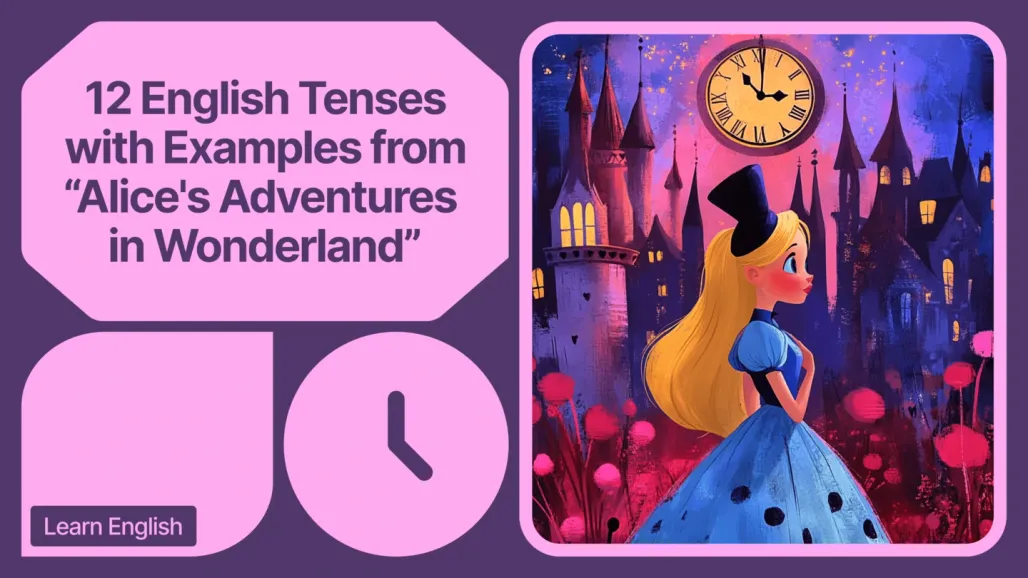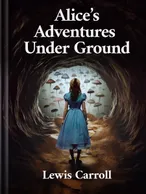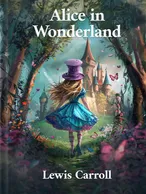12 English Tenses with Examples from 'Alice's Adventures in Wonderland'

English tenses are essential for conveying when an action occurs, helping us understand the timeline of events in writing and conversation. Let's explore the 12 primary tenses in English, each illustrated with quotes from the classic book "Alice's Adventures in Wonderland."
1. Present Simple Tense
2. Present Continuous Tense
3. Past Simple Tense
4. Past Continuous Tense
5. Present Perfect Tense
6. Present Perfect Continuous Tense
7. Past Perfect Tense
8. Past Perfect Continuous Tense
9. Future Simple Tense
10. Future Continuous Tense
11. Future Perfect Tense
12. Future Perfect Continuous Tense
Conclusion
1. Present Simple Tense
The present simple tense describes habitual actions, general truths, and facts.
Example from the book:
“There is no sort of use in knocking.”
“Is” is in the present simple tense, indicating a general state or truth.

2. Present Continuous Tense
The present continuous tense describes actions that are happening right now or are ongoing.
Example from the book:
“I`am opening out like the largest telescope that ever was!”
“Am opening” shows an action currently happening at the moment of speaking.

3. Past Simple Tense
The past simple tense is used for actions that happened at a specific point in the past.
Example from the book:
“Alice opened the door and found that it led into a small passage.”
“Opened” and “found” are in the past simple tense, describing completed actions.

4. Past Continuous Tense
The past continuous tense describes actions that were in progress at a specific time in the past.
Example from the book:
“Alice was beginning to get very tired of sitting by her sister on the bank.”
“Was beginning” is in the past continuous tense, indicating an action that was ongoing in the past.

5. Present Perfect Tense
The present perfect tense is used for actions that occurred at an unspecified time in the past but are relevant to the present.
Example from the book:
“I`ve had nothing yet,” Alice replied in an offended tone.
“I`ve had” is in the present perfect tense, referring to an action relevant to the present moment.

6. Present Perfect Continuous Tense
The present perfect continuous tense is used to describe actions that began in the past and continue up to the present.
Example from the book: This tense is not explicitly used in the text.
However, it would be phrased as, “I have been waiting.”
7. Past Perfect Tense
The past perfect tense is used to describe an action that was completed before another action in the past.
Example from the book:
“she had never before seen a rabbit with either a waistcoat-pocket, or a watch to take out of it, ”
“Had never seen” indicates that this action occurred before another past action.

8. Past Perfect Continuous Tense
The past perfect continuous tense describes an action that was ongoing in the past before another past action.
Example from the book:
“Alice had been looking over his shoulder with some curiosity.”
“Had been looking” shows that the action was ongoing before another event.

9. Future Simple Tense
The future simple tense is used to describe actions that will happen in the future.
Example from the book:
“I shall be late!” said the White Rabbit.
“Shall be late” expresses an action expected to happen in the future.

10. Future Continuous Tense
The future continuous tense is used to describe actions that will be in progress at a specific time in the future.
Example from the book:
“Alice will be exploring Wonderland further in the next few pages.”
“Will be exploring” suggests that the action will be ongoing at a future time.
11. Future Perfect Tense
The future perfect tense is used to describe actions that will be completed before a certain point in the future.
Example from the book:
“By the end of the story, Alice will have learned many lessons.”
“Will have learned” indicates that the action of learning will be completed before the end of the story.
12. Future Perfect Continuous Tense
The future perfect continuous tense describes an action that will have been ongoing for a period of time before a specific point in the future.
Example from the book:
“By the time Alice returns, she will have been wandering in Wonderland for hours.”
“Will have been wandering” shows an action that will continue up until a future moment.
Conclusion
The examples above accurately reflect the text from “Alice's Adventures in Wonderland,” showcasing how different tenses are used to convey various actions and times. This analysis can help learners better understand the application of English tenses in literature.

